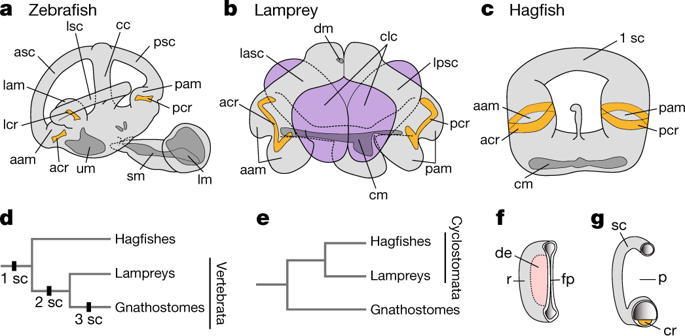Our official English website, www.x-mol.net, welcomes your feedback! (Note: you will need to create a separate account there.)
Inner ear development in cyclostomes and evolution of the vertebrate semicircular canals
Nature ( IF 64.8 ) Pub Date : 2018-12-05 , DOI: 10.1038/s41586-018-0782-y Shinnosuke Higuchi 1, 2 , Fumiaki Sugahara 3, 4 , Juan Pascual-Anaya 4 , Wataru Takagi 5 , Yasuhiro Oisi 6 , Shigeru Kuratani 2, 4
Nature ( IF 64.8 ) Pub Date : 2018-12-05 , DOI: 10.1038/s41586-018-0782-y Shinnosuke Higuchi 1, 2 , Fumiaki Sugahara 3, 4 , Juan Pascual-Anaya 4 , Wataru Takagi 5 , Yasuhiro Oisi 6 , Shigeru Kuratani 2, 4
Affiliation

|
Jawed vertebrates have inner ears with three semicircular canals, the presence of which has been used as a key to understanding evolutionary relationships. Ostracoderms, the jawless stem gnathostomes, had only two canals and lacked the lateral canal1–3. Lampreys, which are modern cyclostomes, are generally thought to possess two semicircular canals whereas the hagfishes—which are also cyclostomes—have only a single canal, which used to be regarded as a more primitive trait1,4. However, recent molecular and developmental analyses have strongly supported the monophyly of cyclostomes5–7, which has left the evolutionary trajectory of the vertebrate inner ear unclear8. Here we show the differentiation of the otic vesicle of the lamprey Lethenteron camtschaticum and inshore hagfish Eptatretus burgeri. This is the first time, to our knowledge, that the development of the hagfish inner ear is reported. We found that canal development in the lamprey starts with two depressions—which is reminiscent of the early developmental pattern of the inner ear in modern gnathostomes. These cyclostome otic vesicles show a pattern of expression of regulatory genes, including OTX genes, that is comparable to that of gnathosomes. Although two depressions appear in the lamprey vesicle, they subsequently fuse to form a single canal that is similar to that of hagfishes. Complete separation of the depressions results in anterior and posterior canals in gnathostomes. The single depression of the vesicle in hagfishes thus appears to be a secondarily derived trait. Furthermore, the lateral canal in crown gnathostomes was acquired secondarily—not by de novo acquisition of an OTX expression domain, but by the evolution of a developmental program downstream of the OTX genes.The differentiation of the inner ear in the lamprey Lethenteron camtschaticum and hagfish Eptatretus burgeri sheds light on the evolution of the semicircular canals of jawed vertebrates.
中文翻译:

环状口内耳的发育和脊椎动物半规管的进化
有颚脊椎动物的内耳具有三个半规管,它们的存在已被用作理解进化关系的关键。Ostracoderms,即无颚的茎有颚类,只有两条运河并且缺乏侧管1-3。作为现代环口的七鳃鳗,通常被认为拥有两条半规管,而同样是环口的盲鳗只有一条管,这在过去被认为是一种更原始的特征 1,4。然而,最近的分子和发育分析有力地支持了 cyclostomes 5-7 的单一性,这使得脊椎动物内耳的进化轨迹不清楚。在这里,我们展示了七鳃鳗 Lethenteron camtschaticum 和近海盲鳗 Eptatretus burgeri 的耳囊的分化。据我们所知,这是第一次,报道了盲鳗内耳的发育。我们发现七鳃鳗的耳道发育始于两个凹陷——这让人想起现代有颚类动物内耳的早期发育模式。这些 cyclostome 耳囊泡表现出一种调节基因的表达模式,包括 OTX 基因,这与 gnathosomes 的表达模式相当。尽管七鳃鳗的囊泡中出现了两个凹陷,但它们随后融合形成了一条类似于盲鳗的通道。凹陷的完全分离导致有颌骨的前管和后管。因此,盲鳗中囊泡的单一凹陷似乎是次要性状。此外,冠颚类的侧管是次要获得的——不是通过从头获得 OTX 表达域,
更新日期:2018-12-05
中文翻译:

环状口内耳的发育和脊椎动物半规管的进化
有颚脊椎动物的内耳具有三个半规管,它们的存在已被用作理解进化关系的关键。Ostracoderms,即无颚的茎有颚类,只有两条运河并且缺乏侧管1-3。作为现代环口的七鳃鳗,通常被认为拥有两条半规管,而同样是环口的盲鳗只有一条管,这在过去被认为是一种更原始的特征 1,4。然而,最近的分子和发育分析有力地支持了 cyclostomes 5-7 的单一性,这使得脊椎动物内耳的进化轨迹不清楚。在这里,我们展示了七鳃鳗 Lethenteron camtschaticum 和近海盲鳗 Eptatretus burgeri 的耳囊的分化。据我们所知,这是第一次,报道了盲鳗内耳的发育。我们发现七鳃鳗的耳道发育始于两个凹陷——这让人想起现代有颚类动物内耳的早期发育模式。这些 cyclostome 耳囊泡表现出一种调节基因的表达模式,包括 OTX 基因,这与 gnathosomes 的表达模式相当。尽管七鳃鳗的囊泡中出现了两个凹陷,但它们随后融合形成了一条类似于盲鳗的通道。凹陷的完全分离导致有颌骨的前管和后管。因此,盲鳗中囊泡的单一凹陷似乎是次要性状。此外,冠颚类的侧管是次要获得的——不是通过从头获得 OTX 表达域,



























 京公网安备 11010802027423号
京公网安备 11010802027423号